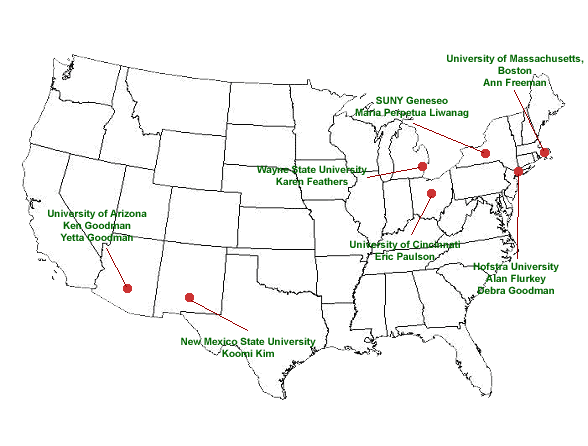
EMMA
Lab and Research
We
have brought two research traditions together to study how perception relates to
comprehension in reading. Eye movement research has for a century been used to
understand how perception in reading provides the brain with sensory input.
Miscue analysis, with over 40 years of history, provides a “window on
the reading process” and reveals the knowledge and strategies readers use as
they comprehend written texts. By a close examination of the relationships of
the expected and observed responses (miscues) in oral reading we get strong
insights into the reader’s process of making sense of written language.
We
call the merged research methodology Eye Movement and Miscue Analysis (EMMA). By
tracking eye movements of readers while we record their oral reading, we produce
a powerful database for the study of readers’ construction of meaning. The
data is both a continuous record of the eye fixations and movements over an
entire text and a continuous record of the oral reading of that text and the
miscues readers produce.
EMMA
Laboratories in the United
States
(click
names on map)

Studies
on Eye Movement and EMMA research
Duckett,
P. (In press). All eyes have it. NH: Heinemann.
Duckett,
P. (2003). Envisioning story: The eye movements of beginning readers.
Literacy Teaching and Learning,
7, (1&2), 77-89.
Duckett,
P. (2002). New insights: Eye fixations and the reading process. Talking
Points,
13 (2), 16-20.
Duckett,
P. (2001). First-grade beginning reader’s use of pictures and print as they
read.
Unpublished doctoral dissertation:
Freeman,
A. (2001). The eyes have it: Oral miscue and eye movement analysis of the
reading of fourth grade Spanish/English bilinguals.
Unpublished doctoral
dissertation:
Kim,
K., Knox, M., and Brown, J. (2007). Eye movements and strategic reading. In
Critical Issues in Literacy Development. NY: Erlbaum.
Meirseitova,
S. & Paulson, E.J. (2001). What does the machine reveal about the
reading process? Based on Russian text material with the use
of an eye movement
fixation apparatus. (In Russian) 1st
National
Paulson,
E. (July, 2005). “Viewing eye movements during reading through the lens of
chaos
theory: How reading is like the weather.” Reading
Research Quarterly, 40
(3).
Paulson,
E., Flurkey, A., Goodman, Y., & Goodman, K. (2003). Eye movements and
miscue analysis:
Yearbook of the National
Paulson,
E. and Freeman, A. (2003). Insight from the eyes: The
science of effective
reading
instruction. NH: Heinemann.
Paulson,
E. & Henry, J. (2002). Does the degree of reading power assessment reflect
the
reading process? An eye-movement examination. Journal
of Adolescent & Adult
Literacy, 46
(3), 234-244.
Paulson,
E. (2002). Are oral reading word omissions and substitutions caused by careless
eye movements? The Journal of Reading
Psychology, 23 (1), 45-66.
Paulson,
E. (2000). Adult readers’ eye movement during the production of oral miscues.
Unpublished doctoral dissertation:
Paulson,
E. & Goodman, K. (January 1999). Influential studies in eye movement
research. Reading Online, www.readingonline.org.
Paulson,
E. & Goodman, K. (1999) “Eye
movements and miscue analysis: What do the
eyes do when a reader makes a miscue?”
Yamashita,
Y. (2003). The processing of the Japanese particles Wa
and Ga using eye
movement research and miscue analysis: Reading comprehension
of a Japanese story
by Japanese English bilinguals. Canadian
Association for Japanese Language
Education,
vol.5, 103-116.
|
ã Duckett 2001 |
Eye Movement and Miscue Analysis
(EMMA) Laboratory Advisory Committee |
Research in progress focuses on
Varied
ages and languages: Elementary school readers, adolescent readers, adult readers,
Chinese readers, Japanese readers, Russian readers, Bilingual Spanish-English
readers, Bilingual French-English readers and speakers of other languages, EMMA
in sight singing (MEMMA).
Varied
materials and other features: illustrated texts, multiple genre text, nonfiction, The Boat in
the Basement, musical notation, effect of font size on EMMA readings, perceptual
units, Retrospective Eye Movement and Miscue Analysis (REMMA).
Support
for LRC Courses and Professional Development
Demonstrations
for and involvement of LRC students and faculty at request.
Main
Items in the EMMA Lab
Model
504 Eye tracker, pan/tilt eye camera, eye camera remote control, *Micron
computers and flat screen monitor, speakers, specialty monitors, microphone
connected to audio tape recorder, *HP laser Jet 3100 fax/printer/copier/scanner,
*Toshiba VCR. (*Supplied by the Goodmans).